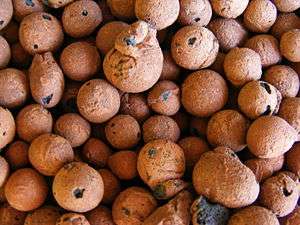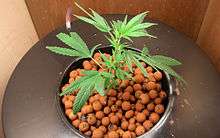Expanded clay aggregate
Lightweight expanded clay aggregate (LECA) or expanded clay (exclay) is a lightweight aggregate made by heating clay to around 1,200 °C (2,190 °F) in a rotary kiln. The yielding gases expand the clay by thousands of small bubbles forming during heating producing a honeycomb structure. LECA has an approximately round or potato shape due to circular movement in the kiln and is available in different sizes and densities. LECA is used to make lightweight concrete products and other uses.

History
LECA was developed about 1917 in Kansas City, Missouri, to the production in a rotary kiln of a patented expanded aggregate known as Haydite which was used in the construction of USS Selma, an ocean-going ship launched in 1919. Following in the USA was the development of a series of aggregates known as Gravelite, Perlite, Rocklite, etc. In Europe, LECA commenced in Denmark, Germany, Netherlands, UK and Middle East.
Characteristics
LECA is usually produced in different sizes and densities from 0.1 millimetres (0.004 in) up to 25 millimetres (1.0 in), commonly 0–4 mm, 4–10 mm, 10–25 mm and densities of 250, 280, 330, and 510 kg/m3. LECA boulder is the biggest size of LECA with 100–500 mm size and 500 kg/m3 density.
Some characteristics of LECA are lightness, thermal insulation by low thermal conductivity coefficient (as low as 0.097 W/mK[1]), soundproofing by high acoustic insulation, moisture impermeability, being incompressible under permanent pressure and gravity loads, not decomposing in severe conditions, fire resistance, a pH of nearly 7, freezing and melting resistance, easy movement and transportation, lightweight backfill and finishing, reduction of construction dead load and earthquake lateral load, being perfect sweet soil for plants, and as a material for drainage and filtration.
Uses
Common uses are in concrete blocks, concrete slabs, geotechnical fillings, lightweight concrete, water treatment, hydroponics, aquaponics and hydroculture.

LECA is a versatile material and is utilized in an increasing number of applications. In the construction industry, it is used extensively in the production of lightweight concrete, blocks and precast or incast structural elements (panels, partitions, bricks and light tiles). LECA used in structural backfill against foundations, retaining walls, bridge abutments etc., in addition, it can reduce earth pressure by 75% compared with conventional materials, and also increases ground stability while reducing settlement and land deformation. LECA can drain the surface water and groundwater to control groundwater pressure. LECA grout can be used for flooring (finishing) and roofing with thermal and sound insulation.
LECA is also used in water treatment facilities for the filtration and purification of municipal wastewater and drinking water as well as in other filtering processes, including those for dealing with industrial wastewater and fish farms.
LECA has uses in agriculture and landscapes. It can alter soil mechanics. It is used as a growing medium in hydroponics systems since blended with other growing mediums such as soil and peat, it can improve drainage, retain water during periods of drought, insulate roots during frost, and provide roots with increased oxygen levels promoting very vigorous growth. LECA can be mixed with heavy soil to improve its aeration and drainage.
See also
References
- "Geotechnical Fill". Norlite Lightweight Aggregate.
- Tor Arne, Hammer; Klaas van Breugel; Steinar Helland; Ivar Holand; Magne Maage; Jan P. G. Mijnsbergen; Edda Lilja Sveinsdóttir (2000). "Economic Design and Construction with Structural Lightweight Aggregate Concrete". Materials for Buildings and Structures. EUROMAT 99. 6. p. 18. doi:10.1002/3527606211.ch3. ISBN 3527301259.